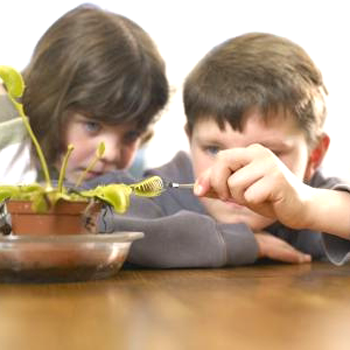
Carnivorous Plant Science Project Ideas
Carnivorous Plant Science Project Ideas
Here is a list of possible carnivorous plant science project ideas for school fairs, classrooms, and more! Many of these come from questions my students have asked about these fascinating plants. Look through the list and use it as a spring board to come up with your own questions to investigate. Let us know about your project, and share any new topics with us.
- Does Venus Flytrap triggering response vary from plant to plant?
- Does Venus Flytrap triggering response vary from leaf to leaf?
- Does Venus Flytrap triggering response vary with age of plant?
- Does Venus Flytrap triggering response vary with the season of the year?
- How is Venus Flytrap closing time related to temperature?
- How is Venus Flytrap closing time related to age?
- How is Venus Flytrap closing time related to humidity?
- How is Venus Flytrap closing time related to soil?
- What soil limits (pH, moisture, composition) can Carnivorous Plants tolerate?
- Is leaf propagation with sundews better with older or younger leaves?
- Is leaf propagation with sundews better with one species or another?
- Which Carnivorous Plant species are most affected by environmental stress?
- Why do Sarracenia hybridize so readily?
- Verify digestion in pitcher plants.
- Which species of Carnivorous Plants are most efficient at trapping insects?
- Is there a relationship between trapping efficiency and soil nutrient deficiency?
- What leaf portions are essential for trapping?
- Are flies attracted by color, smell, shape, etc?
- Are Carnivorous Plant pollinators species-specific?
- What is the most common food of a Carnivorous Plant?
- Is there a relationship between insect spp. trapped and insect spp. density in a bog?
- Do Venus Flytraps prefer flies, ants or bees?
- How many times can a Venus Flytrap leaf be triggered before it dies?
- Can Carnivorous Plants be grown hydroponically?
- Do specific species of Carnivorous Plants trap or lure certain species of prey?
- What symbiotic relationships do Carnivorous Plants have with other organisms?
- What factors affect geographic distribution of Carnivorous Plants within a bog?
- Can false vivipary (plantlet formed instead of flower) be forced on venus flytraps or sundews?
- Do any Carnivorous Plant flowers attract pollinators with ultraviolet color patterns?
- Are Carnivorous Plant pollinators common or rare prey for Carnivorous Plants?
- How does digestive efficiency compare among various Carnivorous Plants?
- Can Carnivorous Plant dormancy be eliminated through environmental or chemical controls?
- Should fertilizers really be avoided when culturing Carnivorous Plants?
- Do wild Carnivorous Plants reproduce more commonly by sexual or asexual methods?
- What significance does the venation pattern in Purple Pitcher Plants play?
- What is the survival advantage of winter leaves (phyllodia) of pitcher plants?
- Does red pigmentation in the Venus Flytrap trap affect trapping efficiency or frequency of insect visitation?
- Is the general public aware of Carnivorous Plants or Carnivorous Plant conservation efforts?
- Can entrapment be stimulated by non-prey techniques: chemical, magnetic, electrical, photic, etc?
- What is the best fungicide to use when germinating or growing Carnivorous Plants?
- How extensive is local parasitism and predation on Carnivorous Plants in your area?
- What specific animal associations can be found with Carnivorous Plants in your area?
- How many times must trigger hairs be touched to trip the trap?
- What is the best time to wait before the second tripping of trigger hair to get the fastest closing of the trap?
- How many times can a Venus Flytrap close before the trap dies?
- Will a Venus Flytrap digest cheese, meat or other protein sources?
- Are Venus Flytrap leaves bigger after feeding?
- In a Carnivorous Plant area compare species density in open sunny areas vs. shaded areas.
- Are Charles Darwin's hypotheses on plant carnivory correct?
- What will trigger the sundew's tentacles and leaves to curl over?
- What strength of a solution can the sundew's tentacles detect?
- What is the smallest mass the sundew's tentacles can detect?
- How fast does a sundew tentacle or leaf respond?
- If one sundew tentacle is stimulated, will others on the leaf also respond?
- How is the growth of a Carnivorous Plant affected by a "meal?"
- Is growth of a Carnivorous Plant after feeding different among different species of Carnivorous Plants?
- Which plants grow in association with Carnivorous Plants?
- What type of insects are attracted by Carnivorous Plants?
- What is the best soil content in which to grow Carnivorous Plants?
- What environmental conditions affect Carnivorous Plants; light, temperature, altitude, drainage, frequency of watering, association with other plants?
- Can germination time be affected by environmental factors?
- What factors affect the timing for appearance of flowers, pollination, fertilization?
- Is there a relationship between trap size and prey type or size?
- Is there a relationship between size and/or type of entrapment and location in the bog?
- What factors affect the rate of new trap formation over time?
- Is the phototropic response of a Carnivorous Plant affected by the capture of prey?
- How is the efficiency of capture related to size of opening, size of leaf, presence of specific parts, age of trap?
- Is the capture rate of a Carnivorous Plant affected by prey size, trap size, age, trap opening size, presence of certain trap parts i.e leaf windows, hood, leaf appendages?
- Is trap efficiency constant among different Carnivorous Plants in the same habitat?
- Is trap efficiency constant among the same Carnivorous Plants in different habitats?
